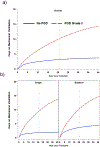Contemporary trends in PGD incidence, outcomes, and therapies
- PMID: 36216694
- PMCID: PMC9990084
- DOI: 10.1016/j.healun.2022.08.013
Contemporary trends in PGD incidence, outcomes, and therapies
Abstract
Background: We sought to describe trends in extracorporeal membrane oxygenation (ECMO) use, and define the impact on PGD incidence and early mortality in lung transplantation.
Methods: Patients were enrolled from August 2011 to June 2018 at 10 transplant centers in the multi-center Lung Transplant Outcomes Group prospective cohort study. PGD was defined as Grade 3 at 48 or 72 hours, based on the 2016 PGD ISHLT guidelines. Logistic regression and survival models were used to contrast between group effects for event (i.e., PGD and Death) and time-to-event (i.e., death, extubation, discharge) outcomes respectively. Both modeling frameworks accommodate the inclusion of potential confounders.
Results: A total of 1,528 subjects were enrolled with a 25.7% incidence of PGD. Annual PGD incidence (14.3%-38.2%, p = .0002), median LAS (38.0-47.7 p = .009) and the use of ECMO salvage for PGD (5.7%-20.9%, p = .007) increased over the course of the study. PGD was associated with increased 1 year mortality (OR 1.7 [95% C.I. 1.2, 2.3], p = .0001). Bridging strategies were not associated with increased mortality compared to non-bridged patients (p = .66); however, salvage ECMO for PGD was significantly associated with increased mortality (OR 1.9 [1.3, 2.7], p = .0007). Restricted mean survival time comparison at 1-year demonstrated 84.1 days lost in venoarterial salvaged recipients with PGD when compared to those without PGD (ratio 1.3 [1.1, 1.5]) and 27.2 days for venovenous with PGD (ratio 1.1 [1.0, 1.4]).
Conclusions: PGD incidence continues to rise in modern transplant practice paralleled by significant increases in recipient severity of illness. Bridging strategies have increased but did not affect PGD incidence or mortality. PGD remains highly associated with mortality and is increasingly treated with salvage ECMO.
Keywords: ECMO; bridge to transplant; lung transplantation; outcomes and lung allocation score; primary graft dysfunction.
Copyright © 2022 International Society for Heart and Lung Transplantation. Published by Elsevier Inc. All rights reserved.
Figures



References
-
- Daud SA, Yusen RD, Meyers BF, et al. Impact of immediate primary lung allograft dysfunction on bronchiolitis obliterans syndrome. Am J Respir Crit Care Med 2007;175(5):507–13. (http://www.ncbi.nlm.nih.gov/entrez/query.fcgi?cmd=Retrieve&db=PubMed&dop... ). - PubMed
Publication types
MeSH terms
Grants and funding
- L32 MD008850/MD/NIMHD NIH HHS/United States
- R01 HL087115/HL/NHLBI NIH HHS/United States
- K12 HL090021/HL/NHLBI NIH HHS/United States
- R01 HL126176/HL/NHLBI NIH HHS/United States
- R01 HL155821/HL/NHLBI NIH HHS/United States
- K24 HL115354/HL/NHLBI NIH HHS/United States
- R01 HL114626/HL/NHLBI NIH HHS/United States
- K23 HL116656/HL/NHLBI NIH HHS/United States
- U01 HL145435/HL/NHLBI NIH HHS/United States
- I01 CX002011/CX/CSRD VA/United States
- R01 HL151552/HL/NHLBI NIH HHS/United States
- K23 HL121406/HL/NHLBI NIH HHS/United States
LinkOut - more resources
Full Text Sources
Medical
Miscellaneous

